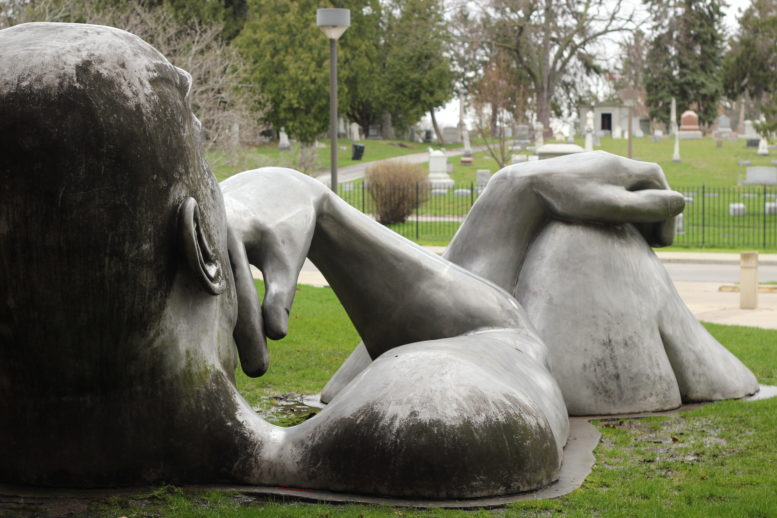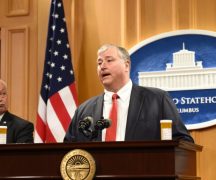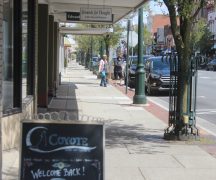BY ANDREW BAILEY
BG Independent News Correspondent
Bowling Green State University’s plan to return to campus on Aug. 26 is a double-edged sword for everyone in the university’s community. A return to campus means a return to the college life that was cut short in the spring, but in a slightly different way given the new health and safety measures established over the summer. But a return to campus also means that if these measures are not strictly adhered to, the coronavirus could spread throughout BGSU’s community and beyond.
These measures include mandatory face masks and social distancing, three instruction delivery formats, rotating cleaning units and an end to in-person classes on Thanksgiving Eve.
But some students fear that these precautions are not enough and have mixed feelings about returning to campus, because one person forgoing hand sanitizer or one uncleaned surface can have a consequential ripple effect.
As of Aug. 13, the state had more than 100,000 reported cases, according to the Ohio Department of Health. Wood County has more than 1,000.*
To make sure no one in the BGSU community becomes another reported case, the university is requiring a self-administered wellness check before arriving on campus each day. One of the ways that these wellness checks can be conducted is by checking your temperature, with the university requesting that “no one come to campus if they are experiencing a temperature that exceeds 100.4 degrees.”
If a thermometer is not available, the university requests that students gauge their health by other means, “including whether you feel that you may have a fever.”
On-campus students may have an advantage in performing more thorough wellness checks though.
The university is providing students living in residential halls with thermometers, Undergraduate Student Government President R. Harrison Carter said.
This leaves off-campus students with the choice of getting their own thermometer or gauging their health through other means, such as checking if they have other possible coronavirus symptoms outlined by the Centers for Disease Control & Prevention.
BGSU has also installed nine to ten temperature check stations around campus that can scan foreheads from a distance, Carter said.
But USG is still pushing for thermometers to be available to all students who will be coming to campus.
“USG has advocated to the Chief Financial Office to make sure that not only do on-campus students have access to those thermometers, but that we want all students to be able to have access to perform those daily wellness checks,” he said. “Not every student is going to have access to a thermometer or a device that can scan their temperature, so that’s what we’re really pushing for.”
On Aug. 7, the university sent out community commitments, one for students and one for employees, that they asked each member of the university to sign, which included committing to the wellness checks, as well as face coverings, physical distancing, being “supportive of other members of the campus community” and more.
With the university offering $1,500 to the first 2,000 students to cancel their on-campus housing assignments, the thermometers that would have been given to these students will become available.
Lack of the ability to perform a thorough wellness check is one of the many concerns raised by students. Self-administered wellness checks, physical distancing and regular hand washing are all individual responsibilities, and enforcing these policies may take more than signing a community commitment.
“Enforcing masks and distancing will surely pose a problem to staff, and student accountability needs to be higher than it would be in other situations,” incoming freshman Emily Jarvis said.
On July 14, Bowling Green passed a citywide mask mandate, which covers BGSU’s campus. Currently, BGSU has not outlined any university-specific procedures for enforcing these safety measures with students walking to and from classes, dining halls and other areas on campus.
“Even if mask resolutions are passed for said instances, they will be nearly impossible to enforce” third year communications major Matt Kaufman said, citing residence halls as well walking around campus as risky for spread of infection.
But despite the uncertainty on how the university will enforce its policies, living on campus may be the best or only option for some students, Jarvis and Kaufman pointed out.
“I’m fortunate enough to be in the position to make the decision to come back to campus or leave if necessary, but I know that not everyone shares the same privilege,” Jarvis said.
But walking around campus and living in residence halls are not the only places students will have to follow strict policies, as the university is offering three course formats for the semester — remote, online and in-person/hybrid — the last of which mixes in-person classes with online components, depending on the course.
BGSU’s Community Health Requirements Policy specifies the obligation to protect personal health and the health of others in the BGSU community. This policy led to BGSU President Rodney Rogers establishing the COVID-19 Personal and Community Health Requirements which were included in the Falcon Forward Commitment sent to all students, faculty and staff, the university said in a statement.
The statement also details the procedures recommended to teachers for ensuring compliance with these policies in in-person and hybrid classes, and how to deal with students who do not follow them, as well as a statement in the syllabus regarding the expectations.
Teachers should request compliance from students in a “positive, supportive, non-threatening manner,” the statement said.
Upon the first infraction of the policies by a student, the statement emphasizes de-escalation. Upon continued infractions, teachers should address the issue in an open forum with the student and engage the class. If the student still refuses to comply, they should be asked to leave the classroom, followed by contacting campus police and notifying administration if the situation escalates even further.
These procedures only apply to in-person and hybrid classes though, and BGSU has stated their commitment to each student’s health and safety.
Rogers announced “Design My BGSU” in a video statement on July 21, an initiative from the university to work with each student to customize their course formats to fit their preferences.
“We also are committed to working with each student to empower them, so that they can choose to be in-person or online,” Rogers said in the statement.
According to the university on the frequently asked questions page of their novel coronavirus page, “More than 70 percent of our classes will have an in-person component that will allow students to interact with faculty and their peers in a safe, physically-distanced manner.”
But it is currently unclear how courses like labs, that utilize hands-on activities to teach, will be for students who choose to take them online.
“Labs, studios and other classes that use specialized rooms or equipment will also have an in-person component that allows students to get the hands-on experience needed to make progress toward their degree. Guidelines will be in place to minimize risk, and these experiences will also be supplemented with online work to ensure that all students get to participate,” the university said.
For Jackie Mader, a fourth year Biology and Psychology major, STEM classes with lab components present the challenge of physically distancing in a small setting while working with partners on exercises, she said.
“I would feel much more comfortable simply taking classes online,” she said.
While she understands the goal of hybrid learning, she finds it hard to believe that “it would be more beneficial than everyone receiving the exact same lecture and information every day online or through Zoom,” she said.
She gave the example of a calculus class she took online as proof of this. “Because the professor was given proper time to prepare for the class, it is working extremely well,” she said. “I think that if every professor was given the proper time to prepare, unlike they were during the spring, it would be easy for classes to be completely online while being successful.
But extra time to prepare to teach a class isn’t always enough to ease concerns. Graduate Student Senate Vice President PA Felton will be teaching a class in the Department of Theatre and Film, which they have sent a request to telecommute for, due to safety concerns for how cleanliness and physical distancing will be maintained.
“I’ve seen a map of the class I’m going to teach in, and the only change that has been made, in the precautions that I can tell for the classroom, is that there is now spots X’ed out between where students should be. But the fact still remains that it’s a very small classroom. I don’t understand how, particularly with only one entrance into class, it’s going to be possible to keep people from coming into close contact,” they said. “I have not seen any evidence for a plan, an effective plan, overall.”
GSS President Blessy McWan, who will be a teaching assistant for a class in the fall semester, also thought the university’s communication on how classes will be run has been vague, specifically in how the classrooms will be cleaned.
“The communication aspect of what will happen after has school starts has been a little unclear. I think we have a general idea, based on the meetings, based on the newsletters that have been sent to us,” she said. “But I think it’s really hard to say if the cleaning process is sufficient enough. I think there is a need for communication to be more clear.”
As part of BGSU’s coronavirus plan, rotating cleaning units will be performing enhanced cleaning throughout campus buildings. With this protocol, they released a frequency chart detailing how often various surfaces will be cleaned, with a priority list starting at one — the cleaning task with the highest priority — and continuing onward, with each subsequent cleaning task having less priority.
According to the chart, classrooms will be disinfected twice per week via electrostatic spray, with a priority listing of one. Door handles will be disinfected multiple times daily with a priority listing of two. “Straighten and clean furniture” is listed with a priority of five, and under the frequency header it states, “Classroom Furniture should not be moved, as it meets capacity and distancing requirements.”
“Wipe all horizontal surfaces, including student desks” is listed with a priority of 13 and a frequency of daily. The list of cleaning protocols for classrooms, conference rooms and computer labs ends with “(V)acuum supply and return air vents,” with a priority of 16 and a frequency of monthly.
Felton said they were “very aware” of the naming of the Allen W. and Carol M. Schmidthorst College of Business, but found navigating BGSU’s novel coronavirus webpage to find the information they wanted to be difficult.
“It’s hard to be able to gauge what the plan is going forward. As an instructor, I feel less prepared than I do as a student,” Felton said.
For everyone returning to campus on Aug. 26, the environment will be far from typical the “college experience.” And when this return to normal will happen, if at all, is still uncertain.
“We associate the college experience with football, with homecoming, with commencement,” Felton said.
With the start of the semester less than two weeks away, students now have to juggle getting the college experience and maintaining healthy and fulfilling social lives with the health and safety requirements imposed by BGSU.
Kaufman is one of these students, who desires the familiar face-to-face interactions that were commonplace before the university moved online in March but acknowledges the risks that returning to campus has.
“On one hand, there’s a part of me that’s very excited to be back in Bowling Green. I consider myself to be a very social person,” he said.
But on the other hand, he sees the university’s plan to return for the fall semester as “characteristic of something that should be happening when cases are on the decline,” even though coronavirus cases in Ohio are rising.
On May 1, Ohio had a cumulative case count of 23,424. Now, the case count is over 100,000, according to the Ohio Department of Health.
Jarvis expressed a similar dichotomy of the social desires of college students and the safety of the community.
“I agree with what seems to be a common stance that the reopening plan takes away from a lot of college experiences such as meeting new friends, getting involved on campus and creating personal connections with professors and students alike. I get that we are operating under adverse circumstances though, so I understand that it’s a sacrifice that needs to be made to get back on campus,” she said.
But with all the variables in play, like student compliance, cleaning and sanitization and no clear plan from the university to prevent symptomatic and asymptomatic students from returning to campus, she does not anticipate the university maintaining its current hybrid model until their scheduled date of Nov. 25 to move fully online.
“I feel like the spread of the virus is inevitable,” she said. “I feel like they’re gonna have to send the whole student body home, that or people are going to be tested and receive a positive result and have to go home anyways.”
And Kaufman sees the high risk of returning to campus in the manner that BGSU is implementing as a reason for why the entire semester should be online-only.
“I seriously do not believe that a return to campus is in the best interest of the student body,” he said. “Having a large group of people concentrated in one area raises the risk for spread dangerously high, no matter how many mandates you enact.”
He sees BGSU’s current plan for returning to campus as fundamentally flawed in its design to prevent the spread of the coronavirus on campus.
But the semester being online-only will fundamentally change the college experience.
“Yes, there will be many sacrifices that we have to make,” he said. “But personally, I believe that stopping the spread of this pandemic should be of our highest priority, and I don’t believe BGSU’s current hybrid plan is designed to do that.”





